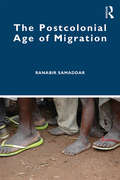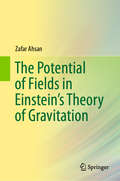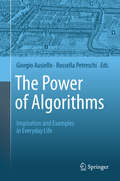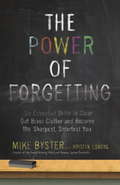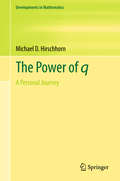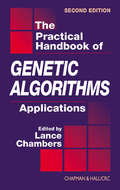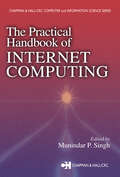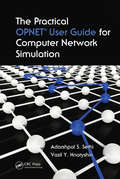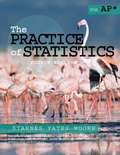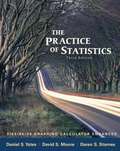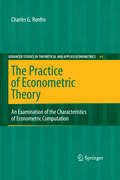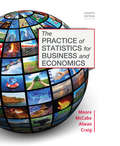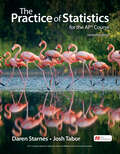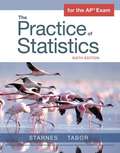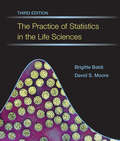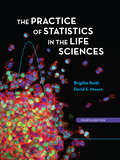- Table View
- List View
The Postcolonial Age of Migration
by Ranabir SamaddarThis book critically examines the question of migration that appears at the intersection of global neo-liberal transformation, postcolonial politics, and economy. It analyses the specific ways in which colonial relations are produced and reproduced in global migratory flows and their consequences for labour, human rights, and social justice. The postcolonial age of migration not only indicates a geopolitical and geo-economic division of the globe between countries of the North and those of the South marked by massive and mixed population flows from the latter to the former, but also the production of these relations within and among the countries of the North. The book discusses issues such as transborder flows among countries of the South; migratory movements of the internally displaced; growing statelessness leading to forced migration; border violence; refugees of partitions; customary and local practices of care and protection; population policies and migration management (both emigration and immigration); the protracted nature of displacement; labour flows and immigrant labour; and the relationships between globalisation, nationalism, citizenship, and migration in postcolonial regions. It also traces colonial and postcolonial histories of migration and justice to bear on the present understanding of local experiences of migration as well as global social transformations while highlighting the limits of the fundamental tenets of humanitarianism (protection, assistance, security, responsibility), which impact the political and economic rights of vast sections of moving populations. Topical and an important intervention in contemporary global migration and refugee studies, the book offers new sources, interpretations, and analyses in understanding postcolonial migration. It will be useful to scholars and researchers of migration studies, refugee studies, border studies, political studies, political sociology, international relations, human rights and law, human geography, international politics, and political economy. It will also interest policymakers, legal practitioners, nongovernmental organisations, and activists.
The Potential of Fields in Einstein's Theory of Gravitation
by Zafar AhsanThis book presents a detailed study of the Lanczos potential in general relativity by using tetrad formalisms. It demonstrates that these formalisms offer some simplifications over the tensorial methods, and investigates a general approach to finding the Lanczos potential for algebraic space–time by translating all the tensorial relations concerning the Lanczos potential into the language of tetrad formalisms and using the Newman–Penrose and Geroch–Held–Penrose formalisms. In addition, the book obtains the Lanczos potential for perfect fluid space–time, and applies the results to cosmological models of the universe. In closing, it highlights other methods, apart from tetrad formalisms, for finding the Lanczos potential, as well as further applications of the Newman–Penrose formalism. Given its scope, the book will be of interest to pure mathematicians, theoretical physicists and cosmologists, and will provide common ground for communication among these scientific communities.
The Power of Algorithms
by Giorgio Ausiello Rossella PetreschiTo examine, analyze, and manipulate a problem to the point of designing an algorithm for solving it is an exercise of fundamental value in many fields. With so many everyday activities governed by algorithmic principles, the power, precision, reliability and speed of execution demanded by users have transformed the design and construction of algorithms from a creative, artisanal activity into a full-fledged science in its own right. This book is aimed at all those who exploit the results of this new science, as designers and as consumers. The first chapter is an overview of the related history, demonstrating the long development of ideas such as recursion and more recent formalizations such as computability. The second chapter shows how the design of algorithms requires appropriate techniques and sophisticated organization of data. In the subsequent chapters the contributing authors present examples from diverse areas - such as routing and networking problems, Web search, information security, auctions and games, complexity and randomness, and the life sciences - that show how algorithmic thinking offers practical solutions and also deepens domain knowledge. The contributing authors are top-class researchers with considerable academic and industrial experience; they are also excellent educators and communicators and they draw on this experience with enthusiasm and humor. This book is an excellent introduction to an intriguing domain and it will be enjoyed by undergraduate and postgraduate students in computer science, engineering, and mathematics, and more broadly by all those engaged with algorithmic thinking.
The Power of Forgetting
by Mike BysterAn uncommon guide for accomplishing more every day by engaging the unique skill of forgetting, from the creator of the award-winning memory training system BraineticsIs it possible that the answer to becoming a more efficient and effective thinker is learning how to forget? Yes! Mike Byster will show you how mastering this extraordinary technique--forgetting unnecessary information, sifting through brain clutter, and focusing on only important nuggets of data--will change the quality of your work and life balance forever.Using the six tools in The Power of Forgetting, you'll learn how to be a more agile thinker and productive individual. You will overcome the staggering volume of daily distractions that lead to to brain fog, an inability to concentrate, lack of creativity, stress, anxiety, nervousness, angst, worry, dread, and even depression. By training your brain with Byster's exclusive quizzes and games, you'll develop the critical skills to become more successful in all that you do, each and every day.d elsewhere, Genius is a bold call for all of us to ignite our inner genius--and live up to our greatest potential.
The Power of Geometric Algebra Computing: For Engineering and Quantum Computing
by Dietmar HildenbrandGeometric Algebra is a very powerful mathematical system for an easy and intuitive treatment of geometry, but the community working with it is still very small. The main goal of this book is to close this gap from a computing perspective in presenting the power of Geometric Algebra Computing for engineering applications and quantum computing. The Power of Geometric Algebra Computing is based on GAALOPWeb, a new user-friendly, web-based tool for the generation of optimized code for different programming languages as well as for the visualization of Geometric Algebra algorithms for a wide range of engineering applications. Key Features: Introduces a new web-based optimizer for Geometric Algebra algorithms Supports many programming languages as well as hardware Covers the advantages of high-dimensional algebras Includes geometrically intuitive support of quantum computing This book includes applications from the fields of computer graphics, robotics and quantum computing and will help students, engineers and researchers interested in really computing with Geometric Algebra.
The Power of q
by Michael D. HirschhornThis unique book explores the world of q, known technically as basic hypergeometric series, and represents the author's personal and life-long study--inspired by Ramanujan--of aspects of this broad topic. While the level of mathematical sophistication is graduated, the book is designed to appeal to advanced undergraduates as well as researchers in the field. The principal aims are to demonstrate the power of the methods and the beauty of the results. The book contains novel proofs of many results in the theory of partitions and the theory of representations, as well as associated identities. Though not specifically designed as a textbook, parts of it may be presented in course work; it has many suitable exercises. After an introductory chapter, the power of q-series is demonstrated with proofs of Lagrange's four-squares theorem and Gauss's two-squares theorem. Attention then turns to partitions and Ramanujan's partition congruences. Several proofs of these are gi ven throughout the book. Many chapters are devoted to related and other associated topics. One highlight is a simple proof of an identity of Jacobi with application to string theory. On the way, we come across the Rogers-Ramanujan identities and the Rogers-Ramanujan continued fraction, the famous "forty identities" of Ramanujan, and the representation results of Jacobi, Dirichlet and Lorenz, not to mention many other interesting and beautiful results. We also meet a challenge of D. H. Lehmer to give a formula for the number of partitions of a number into four squares, prove a "mysterious" partition theorem of H. Farkas and prove a conjecture of R. Wm. Gosper "which even Erdős couldn't do. " The book concludes with a look at Ramanujan's remarkable tau function.
The Practical Handbook of Genetic Algorithms: Applications, Second Edition
by Lance ChambersRapid developments in the field of genetic algorithms along with the popularity of the first edition precipitated this completely revised, thoroughly updated second edition of The Practical Handbook of Genetic Algorithms. Like its predecessor, this edition helps practitioners stay up to date on recent developments in the field and provides material
The Practical Handbook of Genetic Algorithms: New Frontiers, Volume II
by Lance ChambersThe mathematics employed by genetic algorithms (GAs)are among the most exciting discoveries of the last few decades. But what exactly is a genetic algorithm? A genetic algorithm is a problem-solving method that uses genetics as its model of problem solving. It applies the rules of reproduction, gene crossover, and mutation to pseudo-organism
The Practical Handbook of Internet Computing (Chapman & Hall/CRC Computer and Information Science Series)
by Munindar P. SinghThe Practical Handbook of Internet Computing analyzes a broad array of technologies and concerns related to the Internet, including corporate intranets. Fresh and insightful articles by recognized experts address the key challenges facing Internet users, designers, integrators, and policymakers. In addition to discussing major applications, it also
The Practical OPNET User Guide for Computer Network Simulation
by Adarshpal S. Sethi Vasil Y. HnatyshinOne of the first books to provide a comprehensive description of OPNET IT Guru and Modeler software, The Practical OPNET User Guide for Computer Network Simulation explains how to use this software for simulating and modeling computer networks. The included laboratory projects help readers learn different aspects of the software in a hands-on way.Q
The Practice Of Statistics
by David S. Moore Daren S. Starnes Dan Yates YatesCombining a data analysis approach with the power of technology, innovative pedagogy, and a number of new features, The Practice of Statistics is an impressively effective text for learning statistics. The fifth edition has been updated to incorporate Learning Objectives in each section and link them to chapter reviews.
The Practice Of Statistics: Ti-83/84/89 Graphing Calculator Enhanced (Third Edition)
by David S. Moore Daren S. Starnes Dan S. YatesThe Practice of Statistics: TI-83/84/89 Graphing Calculator Enhanced (TPS), Third Edition, is an introductory text that focuses on data and statistical reasoning. It is intended for high school, college, and university students whose primary technological tool is the TI-83, TI-84, or TI-89 graphing calculator. <P><P> This book is based on the successful college textbooks The Basic Practice of Statistics (BPS) by David Moore and Introduction to the Practice of Statistics (IPS) by David Moore and George McCabe. <P>The Practice of Statistics was the first book written specifically for the College Board AP1 Statistics course. Statisticians have reached general consensus about the nature of a modern introductory statistics course. <P> A joint committee of the American Statistical Association and the Mathematical Association of America summarized this consensus as follows: Emphasize statistical thinking Present more data and concepts with less theory and fewer formulas Foster active learning
The Practice of Econometric Theory
by Charles G. RenfroEconometric theory, as presented in textbooks and the econometric literature generally, is a somewhat disparate collection of findings. Its essential nature is to be a set of demonstrated results that increase over time, each logically based on a specific set of axioms or assumptions, yet at every moment, rather than a finished work, these inevitably form an incomplete body of knowledge. The practice of econometric theory consists of selecting from, applying, and evaluating this literature, so as to test its applicability and range. The creation, development, and use of computer software has led applied economic research into a new age. This book describes the history of econometric computation from 1950 to the present day, based upon an interactive survey involving the collaboration of the many econometricians who have designed and developed this software. It identifies each of the econometric software packages that are made available to and used by economists and econometricians worldwide.
The Practice of Statistics
by David S. Moore Daniel S. Yates Daren S. Starnes Josh TaborCombining a data analysis approach with the power of technology, innovative pedagogy, and a number of new features, this fifth edition has been updated to incorporate Learning Objectives in each section and link them to chapter reviews.
The Practice of Statistics (For the AP Exam)
by Daren S. Starnes Dan Yates David Moore Josh TaborCombining a data analysis approach with the power of technology, innovative pedagogy, and a number of new features, this fifth edition has been updated to incorporate Learning Objectives in each section and link them to chapter reviews.
The Practice of Statistics (Prep for the AP* Exam Guide)
by Michael LegacyPractice of Statistics: AP Exam Guide 3rd Edition by Michael Legacy
The Practice of Statistics for AP
by David S. Moore Daniel S. Yates Daren S. StarnesCombining a data analysis approach with the power of technology, innovative pedagogy, and a number of new features, the fourth edition is an impressively effective text for learning statistics.
The Practice of Statistics for Business and Economics
by David S. Moore George P. Mccabe Bruce A. Craig Layth C. AlwanWith The Practice of Statistics for Business and Economics, instructors can help students develop a working knowledge of data production and interpretation in a business and economics context, giving them the practical tools they need to make data-informed, real-world business decisions from the first day of class. With its expanded, dedicated version of LaunchPad, the text more than ever is a seamlessly integrated print/online resource, putting powerful statistical tools and interactive learning features in students' hands.
The Practice of Statistics for the AP® Course
by Josh Tabor Daren StarnesExperience the best: The Practice of Statistics is the ultimate choice for AP® Statistics.Authored by seasoned high school AP® Statistics educators, Daren Starnes and Josh Tabor, along with a team of experienced AP® teacher/leaders, the Seventh Edition of The Practice of Statistics brings a fresh perspective through 9 Units that align perfectly with the CED.Created to instill a deep understanding of the core principles of statistics and the problem-solving methods involved, TPS7 equips students with the essential statistical thinking skills necessary for future endeavors, careers, and everyday decision-making, while also ensuring success on the AP® Statistics Exam. With a multitude of worked examples and practice exercises strategically placed throughout, students have plenty of opportunities to strengthen their skills on a daily basis and prepare for the exam format.And thats not all - the renowned resource program now offers even greater support with the introduction of the new Achieve digital platform. The online homework program has been revamped to provide an extensive homework and assessment system, offering comprehensive support for daily assignments, quizzes, and tests. For students who may be struggling or seeking an extra challenge, the extensive video program is there to offer guidance. Meanwhile, teachers are backed by the most comprehensive Teachers Edition and resource program available. No matter if youre a first-time or experienced AP® Statistics teacher, this program is perfect for you.Better than ever: The Practice of Statistics is the most trusted program for AP® Statistics.
The Practice of Statistics for the AP® Exam
by Josh Tabor Daren Starnes Ann Heath Donald Gecewicz Lumina DatamaticsNIMAC-sourced textbook
The Practice of Statistics for the AP® Exam
by Daren S. Starnes Josh TaborAlong came Dan Yates. His vision for such a text became reality with the publication of The Practice of Statistics (TPS) in 1998. Over a million students have used one of the first five editions of TPS for AP® Statistics! Dan also championed the importance of developing high-quality resources for AP® Statistics teachers, which were originally provided in a Teachers' Resource Binder. We stand on the shoulders of two giants in statistics education as we carry forward their visions in this and future editions. The Practice of Statistics has continued to evolve, thanks largely to the support of our longtime editor and team captain, Ann Heath. Her keen eye for design is evident throughout the pages of the student and teacher's editions. More importantly, Ann's ability to oversee all of the complex pieces of this project while maintaining a good sense of humor is legendary. Ann has continually challenged everyone involved with TPS to innovate in ways that benefit AP® Statistics students and teachers. She is a good friend and an inspirational leader.
The Practice of Statistics in the Life Sciences
by David S. Moore Brigitte BaldiThis remarkably engaging textbook gives biology students an introduction to statistical practice all their own. It covers essential statistical topics with examples and exercises drawn from across the life sciences, including the fields of nursing, public health, and allied health. Based on David Moore's The Basic Practice of Statistics, PSLS mirrors that #1 bestseller's signature emphasis on statistical thinking, real data, and what statisticians actually do. The new edition includes new and updated exercises, examples, and samples of real data, as well as an expanded range of media tools for students and instructors.
The Practice of Statistics in the Life Sciences (Fourth Edition)
by David S. Moore Brigitte BaldiThis remarkably engaging textbook gives biology students an introduction to statistical practice all their own. It covers essential statistical topics with examples and exercises drawn from across the life sciences, including the fields of nursing, public health, and allied health. Based on David Moore's The Basic Practice of Statistics, PSLS mirrors that #1 bestseller's signature emphasis on statistical thinking, real data, and what statisticians actually do. The new edition includes new and updated exercises, examples, and samples of real data, as well as an expanded range of media tools for students and instructors.
The Practice of Statistics: TI-83/84/89 Graphing Calculator Enhanced
by David S. Moore Daniel S. Yates Darren S. StarnesNIMAC-sourced textbook
